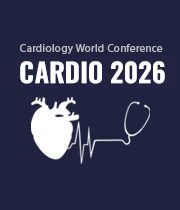Title : Requirement of serial high-sensitivity troponin assays in low-risk patients for ACS with non-ischaemic ECG changes: Are we compliant with the recent guidelines?
Abstract:
Background: The leading symptom triggering the evaluation cascade in patients with suspected Acute Coronary Syndrome (ACS) is acute chest pain. An accurate clinical history, serial electrocardiograms (ECG) and high sensitivity Troponin assays are the cornerstones of prompt and accurate diagnosis guiding further management options. As per ESC’s (European Society of Cardiology) 0h/1 h rule-out and rule-in algorithm for ACS using high- sensitivity cardiac troponin assays in haemodynamically stable patients, ‘NSTEMI can be ruled out at presentation if the hs-cTn concentration is very low.’ Despite endorsement by various international organisations and studies, a trend is observed where patients with low suspicion of ACS clinically, coupled with non-ischaemic ECG changes and 0h Troponin value below level of detection undergo serial troponin level measurements and prolonged observation. This adversely affects cost optimization, promotes layered testing, and encourages testing when the diagnostic yield is low based on patient characteristics. All of these have the potential to compromise patient safety.
Purpose: The study aims to evaluate compliance with ESC’s rule-out algorithm regarding interpretation of single/serial high-sensitive troponin assays in young patients (age<50 years) with low suspicion of ACS and non-ischaemic ECG changes. We further aimed to explore patient outcomes for those undergoing serial Troponin level evaluation (with non-diagnostic value of 1st Troponin assessment) – 2nd diagnostic value of Troponin, length of stay, true incidence of ACS +/- Invasive Coronary Angiography (ICA), true positive ICA.
Methods: A retrospective case note analysis was conducted for all patients aged <50 years with low clinical suspicion of ACS and non-ischaemic ECG changes with non-diagnostic 0/1h Troponin values presenting with chest pain in acute admissions unit of large tertiary care centre from January to February, 2022. We further evaluated their in-patient management, serial investigations, duration of admission and followed up the study population for readmissions, further outpatient cardiac investigations to access coronaries for 1 year.
Results: 207 patients with a mean age of 36.4 +/- 8.8 years fulfilled the inclusion criteria; 13 patients being excluded due to insufficient clinical information and attrition. 9.66% (20) of the study population underwent serial 2nd Troponin level measurements with non-diagnostic 0/1h Troponin levels and non- ischaemic ECG changes. However, none of the patients from this cohort had a diagnostically raised 2nd Troponin value for ACS or underwent ICA in index admission. Baring protracted admissions (>60 hours), the mean length of stay was prolonged by 3.68 hours in the patient cohort undergoing second Troponin measurements compared to the total study population. The primary discharge diagnosis for 2/3rd (67.6%) of all patients was musculoskeletal/non-cardiac chest pain. 50% of patients undergoing serial Troponin levels underwent further OP cardiac investigations, and 3 eventually had a cardiac diagnosis (small calcific plaque in proximal LAD, AVR, Mod - severe LV impairment, 2nd degree HB). 17.3% of the study population represented with chest pain promoting further OP cardiac investigations in 58.3% of them.
Conclusions: The study highlights the high diagnostic accuracy of a very low 0/1h Troponin value coupled with non-ischaemic ECG changes in young patient and endorses safe discharge strategy from acute admissions unit.



